Larry Eckart
Well-known member
“The Land Belongs To Us All, Doesn’t It?” A Photo Essay of Trout Fishing in Tennessee
I just returned from a trip to the mountains of Eastern Tennessee, trout fishing. August is not the best time to do this, due to the higher water temperatures, but it was the only time my friend Ron and I could get our schedules together this fall.
I have written in the past about fishing the Watauga River. This time we fished smaller mountains streams and tiny brooks. Due to the nature of the internet, I will refrain from naming the specific streams we fished.
One of our goals was to hike high enough to find brook trout. We found the right stream, but so did Hurricane Helene last September. The pic below shows one delightful stream that “used to be a good trout stream,” said one fly shop owner.

It is amazing the power of a small stream in flood stage. There were places that looked like a string of bulldozers had pushed rocks where they had not been. Downed trees criss-crossed what had been a fishing trail. Trail no more. Ron and I are both game when it comes to working for trout. But this was nuts.
We dropped down to the parent stream. Caught a few nice rainbows.
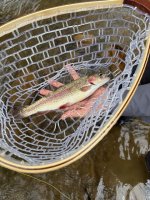
Then the rain came. They say it rains every day in the mountains. Truth! We bivouacked under a bridge and watched and listened to the rain, pouring, slashing the water with mini explosions wherever you looked. It’s not a bad thing to rest under a bridge when it rains. We talked. We watched. We were impatient. Careful with the impatience: rain can bring great things to a stream!
And great things came as the rain died down. It became a trout festival. One cast after another. Hey now! Beautiful fish. Many stockers, but still beautiful fish.
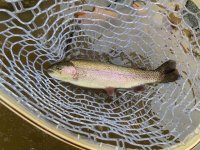
We ended up releasing 15 rainbows caught in about 60 minutes.
Our catch included a few wild fish, per the next photo. You can usually, but not always, tell a wild fish by the more vibrant colors on the sides and cheeks. The tail will also have defined V with sharp edges while the tail of stocked fish is rounded.
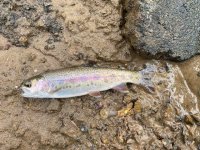
The great thing about small streams is that there are no drift boats. We ran into no other fishermen. The bad thing about small streams is that when it rains, they quickly become unfishable. We had 3 ½ days to fish. Unfortunately, we lost 1 ½ days to swollen, rain-soaked waters.
What to do when the water is too high? We went to a nearby YMCA and worked out. Played some hoops. No, we played H-O-R-S-E. We both grew up at a Lutheran parochial school and played basketball from fifth grade on. We used to have decent jump shots. We still have decent shots, but no jump. While we would rather have been fishing, it was a fun and healthy way to spend some time.
Once the water receded, we were back in the water, literally, wet wading. Part of the fun of small streams is exploring. These streams were new to us, so every bend held an adventure.
Here is a neat waterfall that yielded a few small fish:

A pic of friend Ron fishing under a canopy of trees:
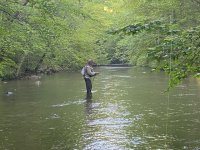
A pic of my last trout. We primarily used a dry/dropper rig with a Chubby Chernobyl dry fly and a nymph on the dropper. Rainbows seem to love pink.
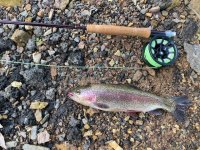
My brother told me that “small streams make you feel like a kid again.” I agree. Here is a photo of Ron and I in our happy place.
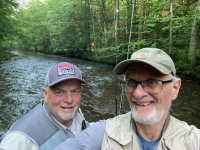
Now about the title of my essay, “The land belongs to us all, doesn’t it?” Ron and I worked down one stream and, done fishing, began to walk back, cutting through the edge of a man’s yard. Out came the owner towards us. You know what I expected, “Get out of here. This is private property.” I asked the man permission to cut across the edge of his lawn. He stopped. We waited for his answer.
“You don’t have to ask, the land belongs to us all, doesn’t it?” was the man’s reply. I was so shocked I couldn’t talk. Never in all my years of hunting and fishing, had I heard such a philosophical answer to the question of access. Ron had to carry on the conversation at first. I was in that “I don’t believe what I just heard,” frame of mind.
We talked for 15 minutes. The man had lived on or near this property for 85 years of his life. We shook hands when we parted.
On my drive home, I wished that I had asked the man if he was Cherokee. His words depicted a different view of land and private property than 99% of Americans. I plan to think of him while I sit in the woods this fall: “the land belongs to us all, doesn’t it?” And when I return to that stream, I will knock on his door and bring him a gift for giving us such a noble surprise in the mountains of Tennessee.
Here is a pic that to me spells, “Cherokee National Forest.”

I will let author Christopher Camuto close this essay with a description of the love Cherokee Indians hold for the natural world they called and still call home:
“To the Cherokee, no river or stream was inconsequential; flowing water was a sign, bright and dark by turns, a descending expression of the land’s ascent, a ceaseless murmur about the birth of the mountains and the passage of time, a surface play of something deeper. These mountain streams were, the Cherokee knew, important seams in the world, and there was nothing fanciful in the fact that water pouring over bedrock produced an animation that compelled attention. A standing wave holds the eye, creating space in the mind. You naturally stop and stare at pools. A Cherokee went to water before gathering medicine, or going to war, or falling in love. You were required to bathe in a stream of predawn darkness before being allowed to hear an important story.”
Another Country: Journeying Toward the Cherokee Mountains, p. 40
I just returned from a trip to the mountains of Eastern Tennessee, trout fishing. August is not the best time to do this, due to the higher water temperatures, but it was the only time my friend Ron and I could get our schedules together this fall.
I have written in the past about fishing the Watauga River. This time we fished smaller mountains streams and tiny brooks. Due to the nature of the internet, I will refrain from naming the specific streams we fished.
One of our goals was to hike high enough to find brook trout. We found the right stream, but so did Hurricane Helene last September. The pic below shows one delightful stream that “used to be a good trout stream,” said one fly shop owner.

It is amazing the power of a small stream in flood stage. There were places that looked like a string of bulldozers had pushed rocks where they had not been. Downed trees criss-crossed what had been a fishing trail. Trail no more. Ron and I are both game when it comes to working for trout. But this was nuts.
We dropped down to the parent stream. Caught a few nice rainbows.

Then the rain came. They say it rains every day in the mountains. Truth! We bivouacked under a bridge and watched and listened to the rain, pouring, slashing the water with mini explosions wherever you looked. It’s not a bad thing to rest under a bridge when it rains. We talked. We watched. We were impatient. Careful with the impatience: rain can bring great things to a stream!
And great things came as the rain died down. It became a trout festival. One cast after another. Hey now! Beautiful fish. Many stockers, but still beautiful fish.

We ended up releasing 15 rainbows caught in about 60 minutes.
Our catch included a few wild fish, per the next photo. You can usually, but not always, tell a wild fish by the more vibrant colors on the sides and cheeks. The tail will also have defined V with sharp edges while the tail of stocked fish is rounded.

The great thing about small streams is that there are no drift boats. We ran into no other fishermen. The bad thing about small streams is that when it rains, they quickly become unfishable. We had 3 ½ days to fish. Unfortunately, we lost 1 ½ days to swollen, rain-soaked waters.
What to do when the water is too high? We went to a nearby YMCA and worked out. Played some hoops. No, we played H-O-R-S-E. We both grew up at a Lutheran parochial school and played basketball from fifth grade on. We used to have decent jump shots. We still have decent shots, but no jump. While we would rather have been fishing, it was a fun and healthy way to spend some time.
Once the water receded, we were back in the water, literally, wet wading. Part of the fun of small streams is exploring. These streams were new to us, so every bend held an adventure.
Here is a neat waterfall that yielded a few small fish:

A pic of friend Ron fishing under a canopy of trees:

A pic of my last trout. We primarily used a dry/dropper rig with a Chubby Chernobyl dry fly and a nymph on the dropper. Rainbows seem to love pink.

My brother told me that “small streams make you feel like a kid again.” I agree. Here is a photo of Ron and I in our happy place.

Now about the title of my essay, “The land belongs to us all, doesn’t it?” Ron and I worked down one stream and, done fishing, began to walk back, cutting through the edge of a man’s yard. Out came the owner towards us. You know what I expected, “Get out of here. This is private property.” I asked the man permission to cut across the edge of his lawn. He stopped. We waited for his answer.
“You don’t have to ask, the land belongs to us all, doesn’t it?” was the man’s reply. I was so shocked I couldn’t talk. Never in all my years of hunting and fishing, had I heard such a philosophical answer to the question of access. Ron had to carry on the conversation at first. I was in that “I don’t believe what I just heard,” frame of mind.
We talked for 15 minutes. The man had lived on or near this property for 85 years of his life. We shook hands when we parted.
On my drive home, I wished that I had asked the man if he was Cherokee. His words depicted a different view of land and private property than 99% of Americans. I plan to think of him while I sit in the woods this fall: “the land belongs to us all, doesn’t it?” And when I return to that stream, I will knock on his door and bring him a gift for giving us such a noble surprise in the mountains of Tennessee.
Here is a pic that to me spells, “Cherokee National Forest.”

I will let author Christopher Camuto close this essay with a description of the love Cherokee Indians hold for the natural world they called and still call home:
“To the Cherokee, no river or stream was inconsequential; flowing water was a sign, bright and dark by turns, a descending expression of the land’s ascent, a ceaseless murmur about the birth of the mountains and the passage of time, a surface play of something deeper. These mountain streams were, the Cherokee knew, important seams in the world, and there was nothing fanciful in the fact that water pouring over bedrock produced an animation that compelled attention. A standing wave holds the eye, creating space in the mind. You naturally stop and stare at pools. A Cherokee went to water before gathering medicine, or going to war, or falling in love. You were required to bathe in a stream of predawn darkness before being allowed to hear an important story.”
Another Country: Journeying Toward the Cherokee Mountains, p. 40

